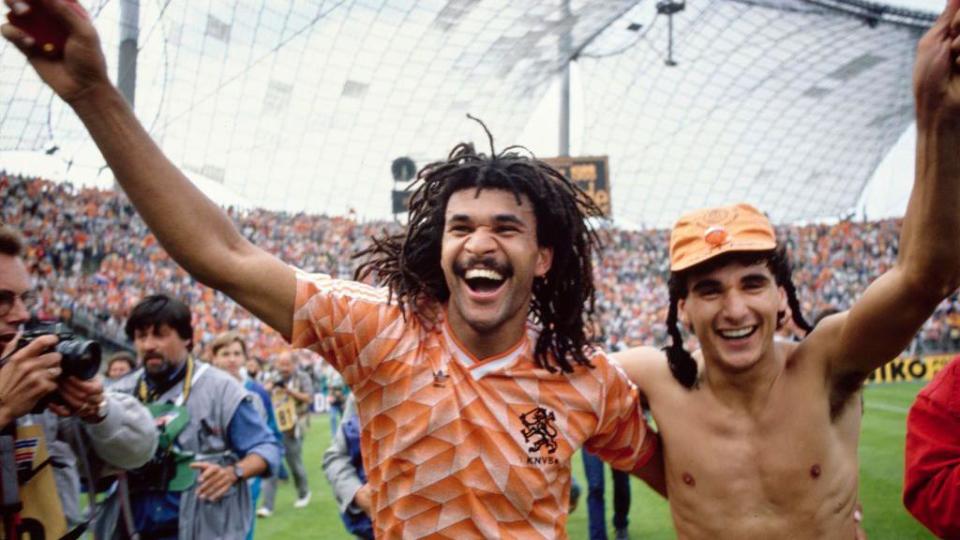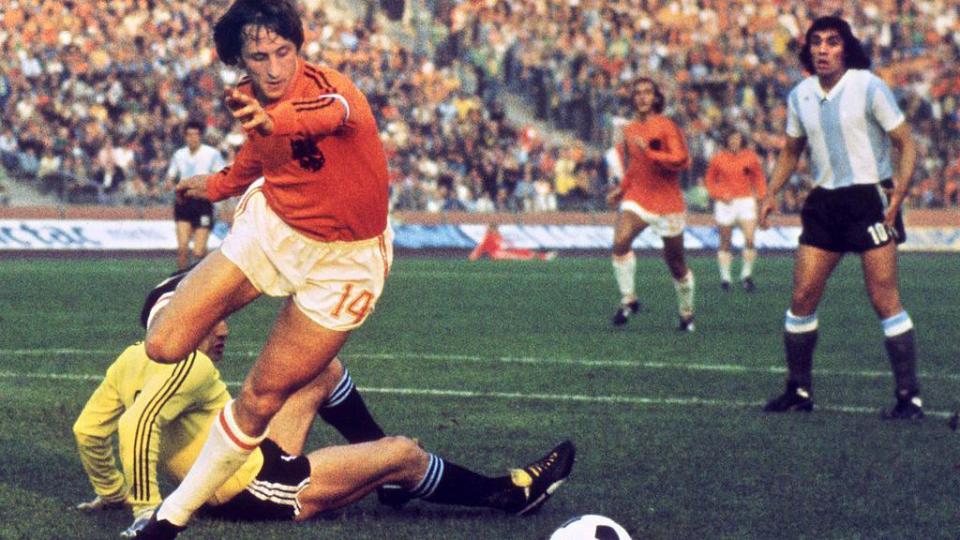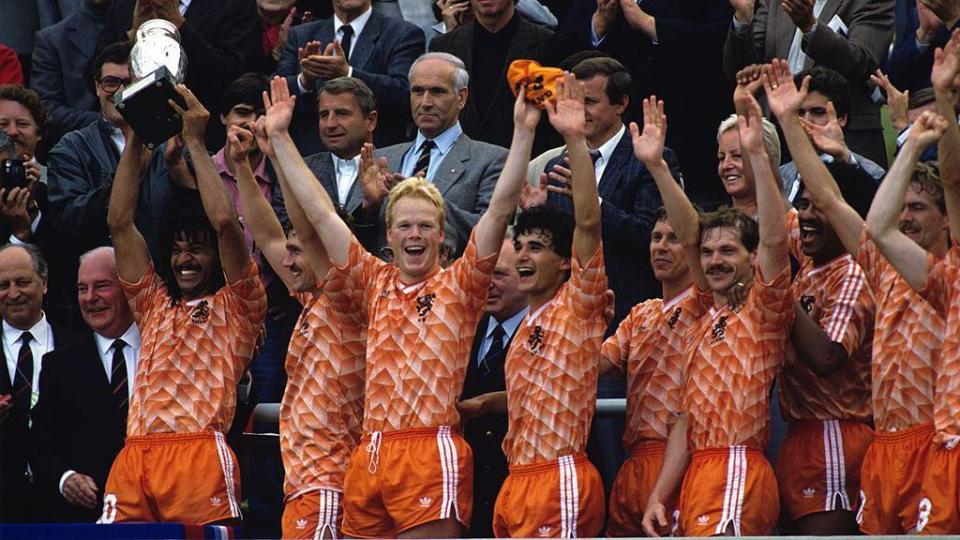Iconic orange, goldfish scales & festivals - why the Dutch kit stands out

Wander through any city that has hosted the Netherlands over the past month at Euro 2024 and it is impossible not to spot swathes of vibrant orange - a colour that is unmistakably and unapologetically Dutch.
"Orange is something that belongs to us, just like the yellow belongs to the Brazilians," explains former Netherlands midfielder Bolo Zenden.
Those resplendent shirts evoke varying memories and emotions depending on your vintage - the Total Football of 1974, mullets, moustaches and the unstoppable volleys of Euro 88.
This summer, it is tens of thousands of fans bouncing side to side behind a double decker bus to the blaring sound of Links Rechts by Dutch party act Snollebollekes.
Yet for a nation so tied to one iconic colour, there have been as many kit controversies as there have been collectors' items.
And, as the Netherlands prepare to face England in the Euro 2024 semi-finals in Dortmund on Wednesday, arguably the two most notable shirt stories have come on German soil.
Formation, Kane & impact subs - Southgate's semi-final dilemmas
Who will win Euros? Insiders from last four give their verdicts
The 'leader', Gakpo's goals & a sea of orange - watch out England
When the Dutch stepped out in Hannover to face Uruguay in their first World Cup match for 36 years in 1974, players sported orange jerseys with the three stripes of Adidas adorning the sleeves. Apart from Johan Cruyff, that is.
The forward was contracted to Puma and had already refused to wear Adidas boots when playing for the national team, despite the Dutch football federation's deal with the German manufacturer.
At the World Cup - after a standoff between the brands, Cruyff and Dutch football bosses - it was decided his kit would have one of the stripes removed.
"The KNVB had signed a contract with Adidas without telling the players," Cruyff wrote in his autobiography, My Turn. "They thought they didn't need to because the shirt was theirs, 'but the head sticking out of it is mine,' I told them."
The row reignited 40 years later after Cruyff's clothing company released a replica of his 1974 jersey, with the legendary player stating in his column for Dutch newspaper De Telegraaf: "Those two stripes belong to me."

Fourteen years later, the jersey sparked the wrath of a nation rather than one man.
The Netherlands won Euro 88, beating hosts West Germany in the semi-final, in what has since become one of the most iconic and desirable shirts of all time.
Before the tournament, though, it was derided by many players and fans, who disliked the pattern and wanted to keep the shirt plain and bright orange.
Captain Ruud Gullit called it "ugly", according to Alex Ireland's Pretty Poly: The History of the Football Shirt.
Meanwhile, winger John van 't Schip said in an interview with Dutch TV: "It is a shame we don't play in a bright orange shirt, how it's supposed to be. The same way the Italians have the beautiful blue, I think we should wear our Orange. We look like goldfish with those scales."
The so-called "Ipswich template" design was only used by the Dutch for that summer, as they went on to beat the USSR to lift the trophy - anyone with an original could well demand a four-figure sum to part with it these days.
"The 1988 iteration really is an all-timer," explains renowned sports designer Matthew Wolff, who has worked on World Cup kits for France and Nigeria.
"Obviously the geometric print is iconic, but I think another reason it's so beloved is it had the perfect model in the effortlessly cool skipper, Ruud Gullit. When I think of that kit, he immediately comes to mind.
"The short shorts, classic black boots, rowdy hair styles and sublime moustaches are also factors in making this one of the greatest looks football has ever seen. Oh and they won the tournament, that's probably a factor too!"

Why do the Netherlands wear orange?
The Netherlands' flag may be red, white and blue but the national colour is definitely orange - that comes from the Dutch Royal Family, the House of Orange-Nassau, which dates back almost 500 years to William of Orange.
Whether it is playing sport or celebrating King's Day, wearing orange is a huge source of pride.
"I have to say that representing your country with the Dutch orange shirt is always special," adds Zenden, who played in England at Chelsea, Middlesbrough and Liverpool. "I don't feel the same with the blue kit, to be honest."
Designing a kit that will be adored by millions of fans comes with huge responsibility.
Arsenio Lopez had that task for the Dutch 2022 Qatar World Cup collection.
"I feel very fortunate to have done that, a sense of responsibility that hopefully you are doing right by the country and the people and they really enjoy it," says the former Olympic swimmer from Puerto Rico.
Like the colour, the national team's badge featuring a lion takes its root from Dutch royalty and Lopez wanted to find a new way of portraying the "power, glow and regalness” of the lion and its mane within the jersey.
He travelled to the Netherlands, spent hours researching players and their personalities and found Memphis Depay, complete with giant lion tattoo on his back, a particular muse. The resulting home shirt featured a flame-like effect.
"The idea was inspired by the brashness and confidence that certain players, like Memphis, were bringing to the team," explains Lopez.
"The importance of the shirt isn't something I take lightly. I really respect the intensity, significance and passion those shirts have and the importance of them."
Passion and intensity are certainly two words that encapsulate the Netherlands supporters in Germany.
Their fan marches are an intoxicating experience and even the players joined in the Links Rechts dance in front of a wall of orange at Berlin's Olympiastadion after their quarter-final win over Turkey.
"It's quite a scene to see," adds Zenden. "It makes you proud and also happy. That's what it should be. Football should be a festival."
Total Football and moustachioed superstars may come and go, but the future for the Netherlands will always be unmistakably and unashamedly bright orange.

 Yahoo Sports
Yahoo Sports 
